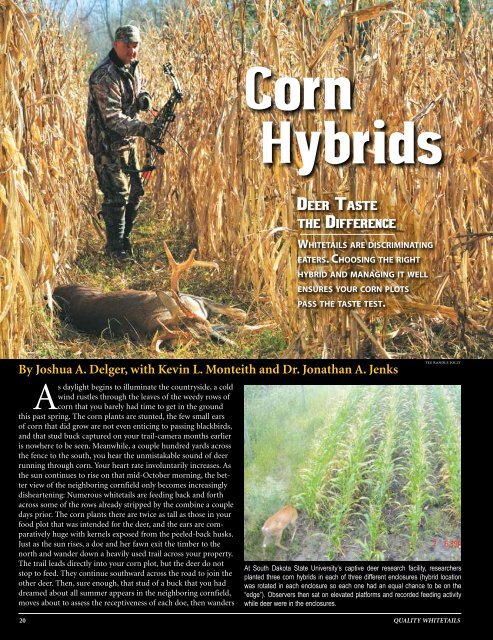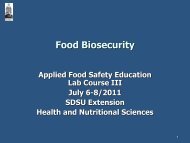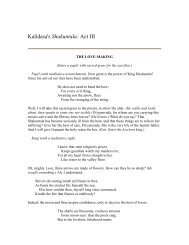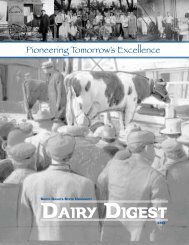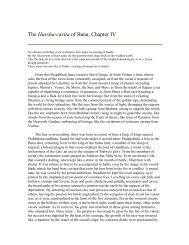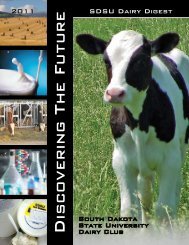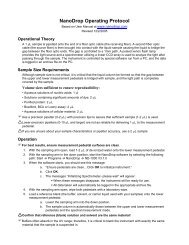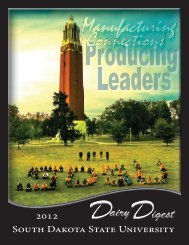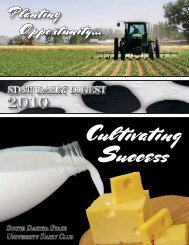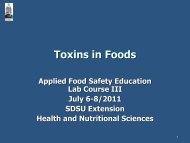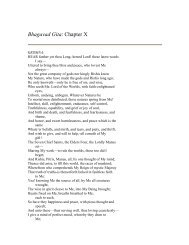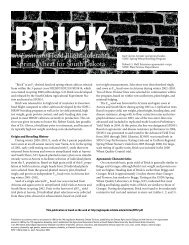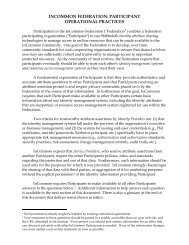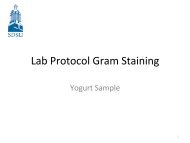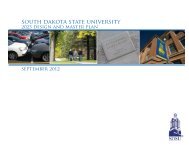Deer TasTe The Difference - South Dakota State University
Deer TasTe The Difference - South Dakota State University
Deer TasTe The Difference - South Dakota State University
Create successful ePaper yourself
Turn your PDF publications into a flip-book with our unique Google optimized e-Paper software.
Corn<br />
Hybrids<br />
<strong>Deer</strong> Taste<br />
the <strong>Difference</strong><br />
Whitetails are discriminating<br />
eaters. Choosing the right<br />
hybrid and managing it well<br />
ensures your corn plots<br />
pass the taste test.<br />
By Joshua A. Delger, with Kevin L. Monteith and Dr. Jonathan A. Jenks<br />
As daylight begins to illuminate the countryside, a cold<br />
wind rustles through the leaves of the weedy rows of<br />
corn that you barely had time to get in the ground<br />
this past spring. <strong>The</strong> corn plants are stunted, the few small ears<br />
of corn that did grow are not even enticing to passing blackbirds,<br />
and that stud buck captured on your trail-camera months earlier<br />
is nowhere to be seen. Meanwhile, a couple hundred yards across<br />
the fence to the south, you hear the unmistakable sound of deer<br />
running through corn. Your heart rate involuntarily increases. As<br />
the sun continues to rise on that mid-October morning, the better<br />
view of the neighboring cornfield only becomes increasingly<br />
disheartening: Numerous whitetails are feeding back and forth<br />
across some of the rows already stripped by the combine a couple<br />
days prior. <strong>The</strong> corn plants there are twice as tall as those in your<br />
food plot that was intended for the deer, and the ears are comparatively<br />
huge with kernels exposed from the peeled-back husks.<br />
Just as the sun rises, a doe and her fawn exit the timber to the<br />
north and wander down a heavily used trail across your property.<br />
<strong>The</strong> trail leads directly into your corn plot, but the deer do not<br />
stop to feed. <strong>The</strong>y continue southward across the road to join the<br />
other deer. <strong>The</strong>n, sure enough, that stud of a buck that you had<br />
dreamed about all summer appears in the neighboring cornfield,<br />
moves about to assess the receptiveness of each doe, then wanders<br />
tes randle jolly<br />
At <strong>South</strong> <strong>Dakota</strong> <strong>State</strong> <strong>University</strong>’s captive deer research facility, researchers<br />
planted three corn hybrids in each of three different enclosures (hybrid location<br />
was rotated in each enclosure so each one had an equal chance to be on the<br />
“edge”). Observers then sat on elevated platforms and recorded feeding activity<br />
while deer were in the enclosures.<br />
20 QUALITY WHITETAILS
deeper into the cornfield until he is out of sight.<br />
Your mind races. Why? Why in the world would deer clearly<br />
choose to feed in an agricultural field over a food plot surrounded<br />
by decent cover that was intended for their use in the first<br />
place? <strong>The</strong> frustration sets in as you call it quits for the morning,<br />
puzzled and disgusted.<br />
This situation occurs all too often. Your neighboring farmers<br />
know exactly how to make corn grow, and for good reason. <strong>The</strong>y<br />
want to produce the healthiest plants resulting in as high a yield<br />
as possible, all in an effort to gain the greatest return. In essence,<br />
this is what we want from our food plots as well, it’s just that our<br />
greatest return happens to sport hooves and carry heavy bone<br />
atop its head. In the following, we will examine why deer might<br />
exhibit such preferential feeding patterns and provide you with<br />
the information necessary to achieve the greatest “return” from<br />
your corn plots next season.<br />
<strong>Deer</strong> Can Detect Nutritional <strong>Difference</strong>s<br />
We recently initiated a three-year study at <strong>South</strong> <strong>Dakota</strong> <strong>State</strong><br />
<strong>University</strong> (SDSU) to determine whether differences in the nutritional<br />
characteristics among various corn hybrids and/or the husbandry<br />
practices were responsible for explaining preferential feeding<br />
patterns by white-tailed deer. Partial funding for this research<br />
was provided by the Berryman Institute and the <strong>South</strong> <strong>Dakota</strong><br />
Agricultural Experiment Station, while the bulk of the funding<br />
came from Federal Aid to Wildlife Restoration administered by<br />
the <strong>South</strong> <strong>Dakota</strong> Department of Game, Fish and Parks. <strong>The</strong> state<br />
wanted to make the best use of food plots implemented by the<br />
U.S. Fish & Wildlife Service on public lands where deer were having<br />
a noticeable negative effect on the cornfields of local farmers.<br />
In the same sense as the example above, deer bypassed food plots<br />
provided by game managers to feed in cornfields planted by the<br />
neighboring farmers.<br />
We implemented a two-part study to gain the most information<br />
possible. Our captive deer herd at SDSU provided the<br />
greatest tool for investigating this issue. Additional facilities were<br />
Percent feeding observations<br />
100<br />
80<br />
60<br />
40<br />
20<br />
0<br />
Sept. 1<br />
Weed Control Matters<br />
Sept. 2<br />
Sept. 6<br />
Sept. 7<br />
Sept. 13<br />
Sept. 14<br />
Sept. 15<br />
Sept. 19<br />
No Herbicide<br />
Herbicide<br />
Sept. 20<br />
Sept. 21<br />
When you fail to control<br />
weeds in a food plot, they<br />
consume space, moisture,<br />
nutrients and sunlight<br />
that could have been used<br />
by your crop, reducing its<br />
nutritional value. Whitetails<br />
in the <strong>South</strong> <strong>Dakota</strong> <strong>State</strong><br />
study spent more than<br />
twice as much time feeding<br />
in corn plots where weeds<br />
were controlled.<br />
constructed where new food plots would be accessible to our<br />
research animals. We planted three different corn hybrids in each<br />
of three food plots and gave study animals access to each plot<br />
over the course of a week while we recorded their feeding activity.<br />
This happened weekly throughout the course of the growing<br />
season. Secondly, research plots were planted cooperatively with<br />
local, private landowners in areas where plots had previously<br />
been established to feed and attract deer. Plots were implemented<br />
in the same fashion as the captive study, but the frequency of<br />
damage to corn plants was used to quantify deer use rather than<br />
direct observations of animals. This research went on to demonstrate<br />
that deer were in fact able to detect subtle differences in<br />
the nutritional quality of hybrids, and consistently fed on those<br />
with higher digestibility over the course of the study. In addition,<br />
white-tailed deer exhibited clear preference for feeding relative to<br />
husbandry practice and location within the food plot.<br />
White-tailed deer are selective feeders, and they select among<br />
food items that will fulfill their nutritional requirements on a<br />
daily basis. But “nutrition” can mean different things. <strong>The</strong>re is<br />
no such thing as a perfect plant for deer, and deer must feed on<br />
a number of different species to obtain essential nutrients. Some<br />
plants will be higher in protein, some higher in fiber, some higher<br />
in fats, while a plant such as corn is high in starch. Starch is basi-<br />
Continued.<br />
<strong>The</strong>se photos were taken at one of the sites in the SDSU study, which compared deer feeding preferences among three corn hybrids planted side-by-side. An interesting<br />
thing to note is the preferred hybrid was located centrally in this plot, which means it had the least amount of edge plants available for deer to consume. <strong>The</strong> authors<br />
discovered that the ears of preferred corn hybrids during the growing season had overall higher digestibility levels for deer. Note: Although these photos show browsing<br />
on the entire corn plant, the study’s findings on browse preference and nutritional quality were based largely on deer consuming corn ears.<br />
DECEMBER 2010 • JANUARY 2011 21
cally a nonstructural carbohydrate and<br />
is easily digested by small ruminants like<br />
white-tailed deer. However, during the<br />
growing season when ears are young and<br />
actively growing, corn is also highly sought<br />
after by deer. <strong>The</strong> ears are moist and contain<br />
sugars that have not yet converted to<br />
starch (this conversion occurs during the<br />
dry-down period later in summer). Corn<br />
is not high in protein, so protein is not the<br />
specific nutrient that deer are targeting in<br />
corn.<br />
Based on the results from our study,<br />
deer were capable of detecting small<br />
differences in digestibility among corn<br />
hybrids and consistently sought the most<br />
digestible hybrid throughout the growing<br />
season. Digestibility is a measure of the<br />
overall soluble materials in a cell in relation<br />
to those that are insoluble. Insoluble<br />
or indigestible materials are namely the<br />
structural components making up the cell<br />
wall in plants. Notice when you eat corn<br />
that it is very soft and easy to chew compared<br />
to something like celery, which contains<br />
much higher levels of insoluble (cell<br />
wall) material. So, it wasn’t one particular<br />
nutrient that deer were choosing for in the<br />
case of corn, but an overall combination<br />
of nutritional components. <strong>The</strong> fact that<br />
deer sought the most digestible hybrids<br />
makes perfect sense from a nutritional<br />
perspective. White-tailed deer, being small<br />
ruminants, do not have the luxury to allow<br />
extensive fermentation of those less digestible<br />
components, compared with large<br />
ruminants such as bison that do. Indeed,<br />
taking expected digestibility of corn<br />
hybrids into consideration prior to planting<br />
has the potential to maximize preferential<br />
feeding by deer. Protein receives<br />
much attention from deer hunters and<br />
land managers, and rightly so, but we need<br />
to think about other vital nutrients as well.<br />
As is the case with many folks planting<br />
food plots, the chosen hybrid planted may<br />
simply be the least expensive or whatever<br />
the local seed dealer has left over in the<br />
warehouse. In contrast, farmers typically<br />
choose hybrids that are expected to grow<br />
best on their soil and produce the highest<br />
yields. A serious food plotter will do<br />
the same. Corn is no different from other<br />
food plot plantings in that you want the<br />
bag of seed you buy to be best suited for<br />
the specific piece of ground you are planting.<br />
Different hybrids of corn are able to<br />
perform better in different environments<br />
relative to soil quality and type, latitudinal<br />
location (thus length of growing season),<br />
and moisture regime. <strong>The</strong> important<br />
thing to know here is the hybrid that performs<br />
best in your plot will be the one<br />
that produces the highest yield, and will<br />
produce the most digestible plant material<br />
(ears/kernels) for deer. Although specific<br />
nutritional information is not always readily<br />
available for corn hybrids, talking with<br />
your local corn seed dealer(s), agricultural<br />
extension agents, and neighboring farmers<br />
will point you in the right direction, and<br />
will help you choose the best hybrid for<br />
your food plot. In addition, if seed companies<br />
have test plots in your area, nutritional<br />
information is often collected from<br />
them. And remember, nutritional data will<br />
differ from site to site, and even from one<br />
end of the plot to the other. You may have<br />
to dig a little deeper for this information,<br />
but going the extra mile here could make<br />
all the difference.<br />
Soil Nutrients and Weed Control<br />
Now the next logical topic to bring<br />
up is fertilizer and herbicide application.<br />
Although it may seem like a nuisance<br />
and you may think, “what does it mat-<br />
22 QUALITY WHITETAILS
ter, deer won’t care.” <strong>The</strong> fact is, deer in<br />
our study spent more than twice as much<br />
time feeding in portions of the food plot<br />
where weeds were controlled as in portions<br />
where weeds were allowed to grow freely.<br />
This was quite apparent to us very early<br />
on during observations. In addition, other<br />
wildlife researchers have clearly shown<br />
increased browsing pressure of ungulates,<br />
such as deer, elk, and moose, on fertilized<br />
areas compared to those that were not<br />
fertilized. Application of fertilizer and herbicide<br />
are critical steps to achieve a food<br />
plot preferred by deer. Fertilizer improves<br />
growth of vegetation, and herbicide application<br />
eliminates weeds that compete for<br />
soil nutrients, water, and sunlight. <strong>The</strong><br />
application of fertilizer and herbicide have<br />
been obvious to farmers and gardeners for<br />
a very long time, but those of us planting<br />
food plots for wildlife sometimes skip<br />
these critical steps. <strong>The</strong>re’s no advantage to<br />
selecting the best corn hybrid to plant on<br />
your property if you don’t properly care<br />
for those plants. Think of it in terms of<br />
growing a big buck: A buck cannot express<br />
his genetic potential if the resources (food)<br />
are not available to get him there, nor will<br />
Continued.<br />
Early vs. Late Maturity: What’s the <strong>Difference</strong>?<br />
A major determinant of which corn hybrids<br />
are available to plant in a specific area is the<br />
maturity rate of the hybrid. Maturity rate typically<br />
refers to the length<br />
of time it takes for the<br />
plant to mature, or reach<br />
its full size. Within a given<br />
area, a later-maturing hybrid<br />
has greater potential<br />
to obtain larger yields,<br />
but runs the risk of not<br />
reaching maturity before<br />
the end of the growing<br />
season; in contrast, there<br />
is much better assurance<br />
that an earlier-maturing<br />
hybrid will reach maturity,<br />
but may yield less because<br />
it terminates growth<br />
sooner.<br />
What we consistently saw<br />
was that earlier-maturing<br />
hybrids were most preferred<br />
by deer during the growing season.<br />
This is likely because earlier maturing hybrids<br />
grow at a faster rate, which within the<br />
plant means it is producing more digestible<br />
materials that deer want to eat rather than<br />
Later-maturing corn varieties may<br />
suffer less ear damage during the<br />
growing season, leaving more ears<br />
available for hunting season and<br />
winter nutrition.<br />
insoluble structural materials. Furthermore,<br />
later-maturing hybrids generally have higher<br />
ear heights than those maturing earlier. A<br />
study published in 1989<br />
by D. K. Ingebrigtsen and<br />
J. B. McAnich documented<br />
deer in winter plots<br />
preferring corn hybrids<br />
with higher ear heights<br />
and more of the ear being<br />
exposed outside of the<br />
husk. A hybrid with higher<br />
ear heights may be more<br />
likely to stand up to winter<br />
weather, while having less<br />
husk covering the ear allows<br />
easier feeding access<br />
by deer.<br />
For these reasons, if you’re<br />
planting corn to provide<br />
winter nutrition for deer,<br />
a later-maturing variety<br />
may be best, but be sure<br />
to plant on time to ensure maturation before<br />
the end of the growing season. If you don’t<br />
mind deer feeding on the ears during the<br />
growing season, before the ears mature, an<br />
early maturing variety is fine.<br />
About This Article<br />
This article was published in Quality Whitetails magazine, the journal of the Quality <strong>Deer</strong><br />
Management Association (QDMA). To become a QDMA member and receive<br />
Quality Whitetails six times a year, use the form below.<br />
Join QDMA and receive Quality Whitetails bi-monthly.<br />
Name<br />
Street<br />
City, <strong>State</strong>, Zip<br />
Daytime Phone ( )<br />
Email<br />
❑ Yes, I would like to receive e-mails about QDMA events, information and promotions.<br />
❑ 1-yr NEW Adult Membership - $30<br />
❑ 3-yr NEW Membership - $80<br />
❑ Mastercard ❑ Visa ❑ AmEx<br />
Card #<br />
Exp. Date<br />
❑ Check # ❑ Money Order #<br />
Fax this form to: 706-353-0223<br />
Or Mail to: QDMA, P.O. Box 160, Bogart, GA 30622<br />
Phone Orders: 800-209-3337<br />
Web Orders: www.QDMA.com<br />
DECEMBER 2010 • JANUARY 2011 23
<strong>South</strong> <strong>Dakota</strong> <strong>State</strong>’s research suggests<br />
deer prefer to feed on the edges<br />
of corn plots. You can use this knowledge<br />
to enhance deer use and huntability<br />
by creating more edge. For<br />
example, plant alternating rows of corn<br />
with another crop, like soybeans (left).<br />
In the reverse, planting large blocks of<br />
corn with less edge will delay feeding<br />
on the interior rows, leaving more corn<br />
for hunting season and winter. Interior<br />
strips can then be mowed to invite<br />
feeding and enhance visibility for hunting<br />
success (below).<br />
a plant be able to express its genetic potential if the nutrients are<br />
not available.<br />
Another important thing to consider is the fact that when we<br />
plant our corn plots we tend to plant them in the same location<br />
year after year. In this situation, failing to fertilize will result in<br />
reduced performance and growth over time. Most farmers rotate<br />
from corn to soybeans in their fields every other year because the<br />
beans are legumes, which are nitrogen-fixing plants. Soybeans<br />
actually put nitrogen back into the soil as they grow. This will<br />
not only produce a nice corn crop for the farmers but will reduce<br />
fertilizer costs as well. Planting corn continually in the same spot<br />
every year is going to deplete those vital nutrients without ever<br />
replacing them.<br />
Silage Corn Hybrids<br />
Silage corn hybrids are engineered to produce more tons of<br />
forage per acre with less investment in ears, just as forage soybeans<br />
put more energy in leaf production than bean production.<br />
Although forage soybeans are a very good choice for deer-sized<br />
ruminants, silage corn hybrids were never intended for deer, but<br />
for cattle, a much larger ruminant. <strong>The</strong> value of a plant is dependent<br />
on the animal species in question, so keep that in mind<br />
when using agricultural products in wildlife applications.<br />
Highest deer use of corn occurs early during ear development<br />
Percent feeding observations<br />
100<br />
80<br />
60<br />
40<br />
20<br />
0<br />
Sept. 6<br />
Edge Matters<br />
Sept. 7<br />
Sept. 14<br />
Sept. 14<br />
Sept. 15<br />
Sept. 19<br />
Internal Row<br />
Edge Row<br />
Sept. 20<br />
Sept. 21<br />
Observations in the <strong>South</strong> <strong>Dakota</strong><br />
<strong>State</strong> study revealed deer strongly<br />
preferred to feed in outer rows of<br />
a corn field. If you want deer to<br />
consume more corn during the<br />
growing season, plant narrow plots<br />
with lots of edge. If you want to<br />
preserve corn for fall and winter<br />
food, plant large blocks, then<br />
mow strips through the corn after<br />
it matures and you are ready to<br />
encourage more use.<br />
bill mayo<br />
and again during late season if ears are still present, and deer by<br />
and large focus on ears while feeding on field corn. In our study,<br />
78 percent of deer feeding activity was focused on ears.<br />
Edge Effect<br />
During our study, it was quickly apparent that deer preferred<br />
to feed on the outside rows of corn plots. Over the course of this<br />
particular experiment, feeding activity occurred on edge rows<br />
nearly 78 percent of the time. Edge rows comprised less than 25<br />
percent of the corn plants available to deer, which emphasizes the<br />
significance of this finding. White-tailed deer are creatures of the<br />
edge and will tend to gravitate to these areas regardless of whether<br />
it is the edge of a woodlot, CRP field, or cornfield.<br />
For those of you familiar with deer hunting in the agricultural<br />
regions of the Midwest, you know how critical the timing<br />
of corn harvest can be to our hunting success. When the harvest<br />
is late, the excitement level on opening day is definitely lower,<br />
knowing full well that huge refuges of cover in the form of giant<br />
cornfields are likely holding many deer, especially after the first<br />
shots begin to ring out across farm country.<br />
SDSU graduate student Kevin Robling is currently doing<br />
radio-telemetry research on white-tailed deer in eastern <strong>South</strong><br />
<strong>Dakota</strong> and has been quickly learning how deer use cornfields<br />
throughout the year, especially some older bucks. <strong>Deer</strong> spend up<br />
to 40 percent of their time in cornfields thanks to the combination<br />
of cover and forage, but our results suggest that given the<br />
choice, deer would rather come out and feed on the edge if possible.<br />
This may be due to differences in nutritional quality of those<br />
plants on edge rows compared to those rows toward the center<br />
of fields. <strong>The</strong>refore, increasing the amount of edge in a corn food<br />
Continued.<br />
24 QUALITY WHITETAILS
plot may maximize use and feeding on<br />
your food plot, and it may make it possible<br />
for you to more effectively hunt deer using<br />
a plot of standing corn.<br />
A simple strategy would be to skip<br />
rows when planting corn in the spring and<br />
fill in the alternating rows with other food<br />
plot items. We would suggest planting the<br />
gaps in high-protein forage like soybeans<br />
to help compensate for the lower protein<br />
content of corn. Also, plant your rows in<br />
an east-to-west orientation to keep the<br />
corn from shading out these other food<br />
plot items. With this strategy, you create<br />
the ideal situation both for the deer and<br />
your own hunting opportunities.<br />
Another simple alternative would be<br />
to plant a large block of corn but then<br />
mow alternating groups of rows of corn<br />
throughout the plot at the end of the<br />
growing season as deer season approaches<br />
(check your state’s hunting regulations to<br />
be sure this is a legal practice). Since the<br />
corn is planted in a large block, deer would<br />
feed less in the interior rows during the<br />
growing season, increasing the number of<br />
ears that make it to maturity and are available<br />
later in year. Strips can be mowed in<br />
the mature stand to allow you to see into<br />
the field from a stand site, and if you time<br />
it right and have fairly clean rows afterward,<br />
you may have time to plant a lateseason<br />
crop like brassicas in the rows.<br />
Using these strategies will provide<br />
deer with the security cover they desire<br />
while at the same time giving them access<br />
to edge rows where they prefer to feed.<br />
Additionally, and probably most importantly,<br />
deer will continue to use these plots<br />
during daylight because cover is still available,<br />
but the openings and strips make it<br />
possible for you to see and hunt deer coming<br />
to the corn field.<br />
Conclusion<br />
Our results suggest that white-tailed<br />
deer are capable of detecting minute differences<br />
in the nutritional quality of food<br />
items, which was evident based on the<br />
preferences for certain corn hybrids. So,<br />
get ahead of the game by thinking more<br />
critically. Select corn hybrids that are<br />
suited to your soils and climate and that<br />
fit your management goals, and then manage<br />
weeds and soil nutrients to ensure the<br />
plants perform to their potential. Your<br />
hunting success may improve, and you<br />
may be doing your neighboring<br />
farmers a favor as well.<br />
About the Authors: Joshua Delger of<br />
Wall, <strong>South</strong> <strong>Dakota</strong>, has been conducting<br />
wildlife research since 2003, obtaining<br />
his bachelor’s and master’s degrees in<br />
Wildlife and Fisheries Sciences from <strong>South</strong><br />
<strong>Dakota</strong> <strong>State</strong> <strong>University</strong>. Josh is currently<br />
a resource biologist for the National Park<br />
Service at Badlands National Park.<br />
Kevin Monteith is a doctoral candidate at<br />
Idaho <strong>State</strong> <strong>University</strong> in biological sciences.<br />
Kevin obtained his bachelor’s and<br />
master’s degrees in Wildlife and Fisheries<br />
Sciences at <strong>South</strong> <strong>Dakota</strong> <strong>State</strong> <strong>University</strong><br />
and has conducted research on large ungulates<br />
since 1999.<br />
Dr. Jonathan A. Jenks is a Distinguished<br />
Professor of Wildlife and Fisheries Sciences<br />
at <strong>South</strong> <strong>Dakota</strong> <strong>State</strong> <strong>University</strong>. He has<br />
worked with white-tailed deer and other<br />
large mammals for 25 years, and has published<br />
more than 100 articles on big game<br />
ecology and management. He has been the<br />
academic advisor and has provided oversight<br />
on all research activities at SDSU’s<br />
captive deer research facilities since its<br />
inception in 1997.<br />
26 QUALITY WHITETAILS


